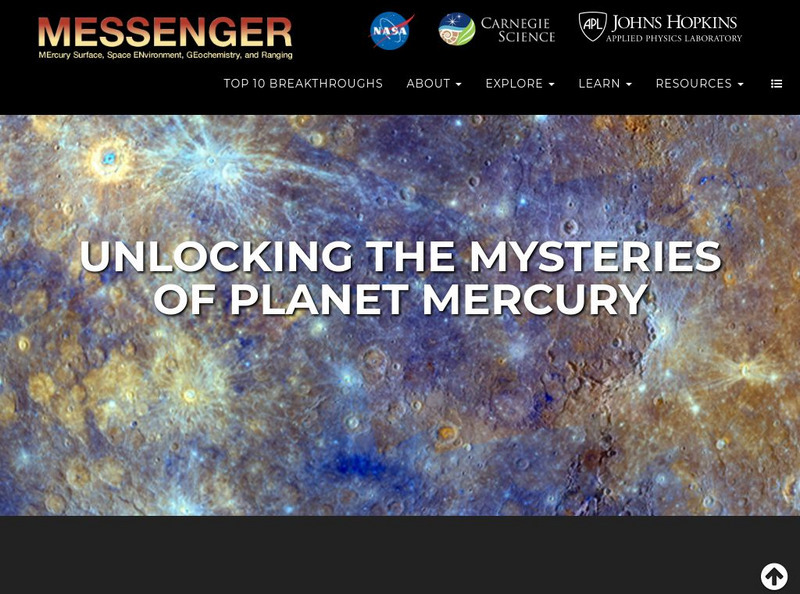Hi, what do you want to do?
Curated OER
Symmetry: Theory, Reality and Art!
Pupils explore the concept of geometric symmetry. In this geometric symmetry lesson, students walk around their school and take pictures of objects that demonstrate symmetry. Pupils use Microsoft Paint to draw the lines of symmetry on...
Curated OER
The Lift Equation Problem Set
Students, after reading the Lift Equation page from a NASA Web-based textbook, demonstrate an understanding of the lift equation by answering questions.
Curated OER
Altitude and Flight Forces
Students use the World Wide Web to access and use FoilSim. They also use the World Wide Web to access the NASA Glenn Web site for information relative to the factors involved with the flight of an airplane.
Curated OER
Exploring the Celestial Neighborhood
Ninth graders study the origin and organization of the solar system. They investigate the Earth's place in the system and how planetary motions explain natural phenomena observable from Earth.
Curated OER
Here's Looking at You
Students assess some common inherited traits which are easily observable and note their phenotype for the trait. Students compare their phenotypes to those of their parents and attempt to describe the pattern and manor of inheritance.
Cosmo Learning
Cosmo Learning: Applied Science and Technology 210: Electrical Engineering
A collection of video lectures from a course that explores the application of electrical engineering topics. Webpage includes twenty-eight lectures from a professor at the University of California, Berkeley. Lectures vary in length and...
Science Struck
Science Struck: Guide to Free Body Diagrams in Physics
A detailed explanation of the different types of forces that can be applied to an object and how to represent them in a free body diagram. Includes examples and some practice problems to try, with solutions provided.
Georgia Department of Education
Ga Virtual Learning: Physical Science: Force and Motion
In this student-paced module, students apply Newton's Laws of Motion to everyday life, calculate mathematical relationships involving force and motion using algebraic formulas, and understand the difference between mass and weight.
Science Buddies
Science Buddies: Guitar Fundamentals: Wavelength, Frequency, & Speed
This is a rockin' project for guitarists with an interest in the physics behind music. If you have ever wondered why the pitch of the note changes when you fret the string, this project will help you understand by applying basic...
Georgia Department of Education
Ga Virtual Learning: Ap Environmental Science: Course Introduction
An introduction to Environmental Science, an interdisciplinary field of study that integrates the biological and physical sciences in an effort to understand environmental systems, and the solutions to both man-made and natural...
Georgia Department of Education
Ga Virtual Learning: Ap Physics 1: Applications of Newton's Laws of Motion
Students apply Newton's laws to more diverse physical settings where multiple forces from varying origins interact. To aid in condensing the physical setting into mathematical expressions, the free body diagram is used in this module...
Georgia Department of Education
Ga Virtual Learning: Ap Physics 1: Simple Harmonic Motion
In this unit, students will discover the period of time of one oscillation, the frequency of oscillation, the object displacement, its velocity, and its acceleration. They will also discover how to apply the principles of conservation of...
Pennsylvania State University
Applied Physics: Experimental Research on Baseball Bat Vibrations
Fun science site that explores the vibrational behavior of a baseball/softball bat. Contains links to mode splitting in wood bats, controlling vibration, measuring the vibration of a baseball/softball bat and more!
Pennsylvania State University
Applied Physics: Model Analysis of an Electric Guitar
Great site explores the physics behind an electrical guitar. Outlines process for conducting an experiment on sound vibrations and provides animated GIF movies showing the first five modes of vibration.
National Institute of Standards and Technology (NIST)
Nist: Physics Measurement Laboratory: Marie Curie and the Nbs Radium Standards
Use this site to learn about Marie Curie and her work with radioactivity which earned her worldwide recognition and two Nobel Prizes. This gallery is organized into a "timeline" of significant events, from 1913 to the present, in which...
Khan Academy
Khan Academy: Applying Gravity to a Particle
Understand how we simulate the effect of gravity on a particle.
American Association of Physics Teachers
Com Padre Digital Library: Open Source Physics: Schwarzschild Particle Energy
Apply the Schwarzschild metric to an object orbiting about a black hole. Manipulate the energy and angular momentum of the orbiting particle and observe the results.
American Association of Physics Teachers
Com Padre Digital Library: Open Source Physics: Schwarzschild Light Wavefront
Apply the Schwarzschild metric to the paths light travels when it radiates in every direction near a black hole. Adjust the position of the light source and observe the effective potential of the paths.
Johns Hopkins University
Applied Physics Laboratory: Messenger Home
Home page for NASA's Discovery Program Messenger to the planet Mercury. Site provides details of the planned mission, its experiments and the science and management teams. Linked Quicktime animation files are very large and detailed....
Pennsylvania State University
Applied Physics: Vibrational Modes of a Circular Membrane (Drums)
Site tracks the vibrations of a drum and provides an animated movie.
CK-12 Foundation
Ck 12: Physical Science: Newton's First Law
[Free Registration/Login may be required to access all resource tools.] Newton's first law of motion and how it applies in skateboarding.
Middle School Science
Middle School Science: Balloon Powered Race Cars
An idea developed by a physical science teacher who applied Newton's Laws of Motion in creating a balloon powered race car. Find simple objective, materials, rules, and procedures.
CK-12 Foundation
Ck 12: Physical Science: Newton's Third Law
[Free Registration/Login may be required to access all resource tools.] Newton's Third Law of Motion - action and reaction forces and why they are not balanced forces.
NASA
Sci Jinks: Learn Satellite Meteorology
A collection of learning modules is offered to enhance studying meteorology. This opportunity should peek students' interests as they work through geoscience, physics, chemistry, and applied sciences. Each module includes exercises and...























